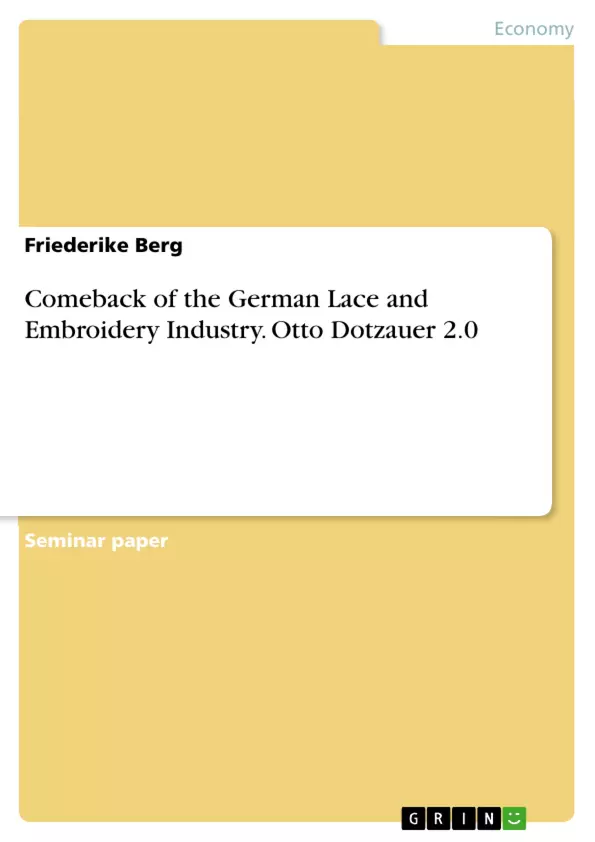The personal motivation selecting this capstone project topic goes back to 2014. I visited Otto Dotzauer’s factory with my undergraduate study group in a small town in Saxony, South-East Germany. The company consists of an office and one factory hall which has a few types of machinery that operate in an old traditional way and with less automation.
Despite Meinels Stick and Designerspitzen Plauen GmbH, it is one of three companies in this region that preserves the German textile heritage. The products of Otto Dotzauer are considered as traditional craftsmanship.
Inhaltsverzeichnis (Table of Contents)
- INTRODUCTION
- Background
- History of the German Lace and Embroidery Industry
- ANALYSIS OF THE CURRENT STATE
- Company Purpose and Team
- Product, Customer and Value Proposition
- Go-to-Market Strategy
- Financials
- OTTO DOTZAUER 2.0
- Problem
- Market Opportunity, Trends and Competition
- Growth Strategy
- Product and Price Strategy
- Customer Acquisition Strategy
- Marketing Strategy
- Sales and Distribution Strategy
- Process and Team Strategy
- Financials and Forecast
Zielsetzung und Themenschwerpunkte (Objectives and Key Themes)
This paper explores the revitalization of the German lace and embroidery industry through the lens of Otto Dotzauer, a family-owned business rooted in the centuries-old tradition of Plauen lace. The paper aims to analyze the company's current state, identify key challenges facing the industry, and develop a strategic roadmap for its comeback under the banner of "Otto Dotzauer 2.0." The paper also seeks to raise awareness of the value of German lace and embroidery and reintroduce it to younger generations.
- The decline of the German lace and embroidery industry due to competition from Asia, price pressure, and lack of digitalization
- The importance of preserving craftsmanship and traditional techniques
- Developing a modern and innovative strategy to attract younger generations
- Leveraging the unique heritage and quality of Plauen lace to create a competitive advantage
- Strategic considerations for growth, product development, and market penetration
Zusammenfassung der Kapitel (Chapter Summaries)
The "Introduction" chapter provides a comprehensive overview of the German lace and embroidery industry, highlighting the historical significance of Plauen lace and its current challenges. The chapter also details the author's motivation for choosing this capstone project topic, drawing upon their personal experiences with Otto Dotzauer and 1 Atelier.
The "Analysis of the Current State" chapter delves into the specifics of Otto Dotzauer's operation, examining its purpose, team, product offerings, customer base, and value proposition. This chapter provides a detailed overview of the company's current structure and its strengths and weaknesses.
The "Otto Dotzauer 2.0" chapter outlines the strategic plan for the company's revitalization. This includes addressing the challenges facing the industry, defining the company's market opportunity, and developing a comprehensive growth strategy encompassing product development, customer acquisition, marketing, sales, distribution, process optimization, team building, and financial projections.
Schlüsselwörter (Keywords)
The paper explores the critical aspects of the German lace and embroidery industry, focusing on topics such as: traditional craftsmanship, Plauen lace, Otto Dotzauer, digitalization, market challenges, growth strategies, product development, customer acquisition, marketing, sales, distribution, and team building. Key concepts include the importance of preserving heritage, attracting younger generations, and leveraging innovative strategies to revitalize a traditional industry.
- Arbeit zitieren
- Friederike Berg (Autor:in), 2019, Comeback of the German Lace and Embroidery Industry. Otto Dotzauer 2.0, München, GRIN Verlag, https://www.grin.com/document/505687



